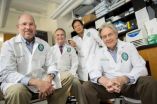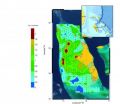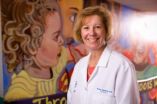(Press-News.org) PROVIDENCE, R.I. [Brown University] — The U.S. Preventive Services Task Force recently recommended computerized tomography (CT) lung screening for people at high risk for cancer, but a potential problem with CT is that many patients will have positive results on the screening test, only to be deemed cancer-free on further testing. Many policymakers have expressed concern that this high false-positive rate will cause patients to become needlessly upset. A new study of National Lung Screening Trial participant responses to false positive diagnoses, however, finds that those who received false positive screening results did not report increased anxiety or lower quality of life compared with participants who received negative screen results.
"Most people anticipated that participants who were told that they had a positive screen result would experience increased anxiety and reduced quality of life. However, we did not find this to be the case," said Ilana Gareen, assistant professor (research) of epidemiology in the Brown University School of Public Health and lead author of the study published in the journal Cancer.
The NLST's central finding, announced in 2010, was that screening with helical CT scans reduced lung cancer deaths by 20 percent compared to screening with chest X-rays. The huge trial spanned more than a decade, enrolling more than 53,000 smokers at 33 sites.
In the new study, Gareen and co-authors, including Brown faculty and staff members Fenghei Duan, Constantine Gatsonis, Erin Greco, and Bradley Snyder, followed up with a subset of participants at 16 sites to assess the psychological effects of the CT and X-ray screenings compared in the trial.
"In the context of our study, with the consent process that we used, we found no increased anxiety or decreased quality of life at one or six months after screening for participants having a false positive," Gareen said. "What we expected was that there would be increased anxiety and decreased quality of life at one month and that these symptoms would subside by six months, which is why we measured at both time points, but we didn't find any changes at either time point."
The unexpected similarity between the participants with a negative and a false positive screen result is not because getting a false positive diagnosis is at all pleasant, Gareen said, but presumably because study participants understood that there was a high likelihood of a false positive screen result.
"We think that the staff at each of the NLST sites did a very good job of providing informed consent to our participants," she said. "In advance of any screening, participants were advised that 20 to 50 percent of those screened would receive false positive results, and that the participants might require additional work-up to confirm that they were cancer free."
Reassuring results
To make its assessments, Gareen's team surveyed 2,812 NLST participants for the study. Patients responded well, with 2,317 returning the survey at one month after screening and 1,990 returning the survey at six months. The survey included two standardized questionnaires: the 36-question Short Form SF-36, which elicits self-reports of general physical and mental health quality, and the 20-question Spielberger State Trait Anxiety Inventory.
Maryann Duggan and her staff from the Outcomes and Economics Assessment Unit at Brown administered the questionnaires by mail with telephone follow-up as required.
In the study analysis, the researchers divided people into groups based on their ultimate accurate diagnoses: 1,024 participants were "false positive," 63 were "true positive," 1,381 were "true negative" and 344 had a "significant incidental finding," meaning they didn't have cancer but instead had another possible problem of medical importance.
The results were clear after statistical adjustment for factors that could have had a confounding influence. Whether participants received X-rays or the helical CT scans, the questionnaire scores of those with false positive diagnoses remained similar to those who were given true negative diagnoses.
Meanwhile, the scores of the true positive participants who were diagnosed with lung cancer markedly worsened over time as their battle with the disease took a physical and psychological toll.
Because participants received the questionnaires at one and six months, it is possible that study participants receiving a false positive screen result experienced anxiety and reduced quality of life for a short time after receiving their screen result, Gareen said. But by one month after their screening, there was no evidence of a difference between the screen result groups.
Gareen said the results should encourage physicians to recommend appropriate screenings, despite their high false positive rates, so long as patients are properly informed of the likelihood of a positive screen result and its implications. The data provide evidence that the NLST consent process provided a good model for advising those undergoing screening, she said.
INFORMATION:
In addition to those at Brown, the other authors are Dr. Phillip Boiselle and Elyse Park of Harvard Medical School and Dennis Fryback of the University of Wisconsin.
The National Cancer Institute funded the NLST, including this study (grants: U01-CA-80098, CA 79778). The study was conducted by the NCI-funded American College of Radiology (ACRIN), now part of the ECOG-ACRIN Cancer Research Group.
Informed consent: False positives not a worry in lung cancer study
2014-07-25
ELSE PRESS RELEASES FROM THIS DATE:
Exposure to dim light at night may make breast cancers resistant to tamoxifen
2014-07-25
PHILADELPHIA — For rats bearing human breast tumors, exposure to dim light at night made the tumors resistant to the breast cancer drug tamoxifen, according to data published in Cancer Research, a journal of the American Association for Cancer Research. The negative effects of dim light exposure on tamoxifen treatment were overcome by giving rats a melatonin supplement during the night.
"Resistance to tamoxifen is a growing problem among patients with hormone receptor-positive breast cancer," said Steven M. Hill, PhD, professor of structural and cellular biology and the ...
Total darkness at night is key to success of breast cancer therapy -- Tulane study
2014-07-25
Exposure to light at night, which shuts off nighttime production of the hormone melatonin, renders breast cancer completely resistant to tamoxifen, a widely used breast cancer drug, says a new study by Tulane University School of Medicine cancer researchers. The study, "Circadian and Melatonin Disruption by Exposure to Light at Night Drives Intrinsic Resistance to Tamoxifen Therapy in Breast Cancer," published in the journal Cancer Research, is the first to show that melatonin is vital to the success of tamoxifen in treating breast cancer.
Principal investigators and ...
Zerenex™ (ferric citrate) long-term Phase 3 study results published in JASN
2014-07-25
New York, NY - July 24, 2014 -- Keryx Biopharmaceuticals, Inc. (Nasdaq:KERX) (the "Company") announced the publication of results from the long-term, randomized, active control Phase 3 study of Zerenex (ferric citrate), the Company's investigational oral ferric iron-based phosphate binder, for the treatment of hyperphosphatemia in patients with end-stage renal disease (ESRD) on dialysis. The PERFECTED study (PhosphatE binding and iRon delivery with FErric CiTrate in EsrD) was published online today in the Journal of the American Society of Nephrology (JASN).
This Phase ...
New research suggests Saharan dust is key to the formation of Bahamas' Great Bank
2014-07-25
MIAMI – A new study suggests that Saharan dust played a major role in the formation of the Bahamas islands. Researchers from the University of Miami (UM) Rosenstiel School of Marine and Atmospheric Science showed that iron-rich Saharan dust provides the nutrients necessary for specialized bacteria to produce the island chain's carbonate-based foundation.
UM Rosenstiel School Lewis G. Weeks Professor Peter Swart and colleagues analyzed the concentrations of two trace elements characteristic of atmospheric dust – iron and manganese – in 270 seafloor samples collected along ...
Overweight and obese preschoolers lose more weight when parent is also treated
2014-07-24
BUFFALO, N.Y. – Primary care treatment of overweight and obese preschoolers works better when treatment targets both parent and child compared to when only the child is targeted, according to research published this week in Pediatrics and conducted at the University at Buffalo and Women and Children's Hospital of Buffalo.
Children enrolled in this study were overweight or obese and had one parent who participated in the study who also was overweight or obese, according to body mass index (BMI) measurements, calculated based on height and weight.
During the course of the ...
NYSCF scientists one step closer to cell therapy for multiple sclerosis patients
2014-07-24
NEW YORK, NY (July 24, 2014) – Scientists at The New York Stem Cell Foundation (NYSCF) Research Institute are one step closer to creating a viable cell replacement therapy for multiple sclerosis from a patient's own cells.
For the first time, NYSCF scientists generated induced pluripotent stem (iPS) cells lines from skin samples of patients with primary progressive multiple sclerosis and further, they developed an accelerated protocol to induce these stem cells into becoming oligodendrocytes, the myelin-forming cells of the central nervous system implicated in multiple ...
Study indicates large raptors in Africa used for bushmeat
2014-07-24
Bushmeat, the use of native animal species for food or commercial food sale, has been heavily documented to be a significant factor in the decline of many species of primates and other mammals. However, a new study indicates that more than half of the species being consumed are birds, particularly large birds like raptors and hornbills.
"By surveying not only the meat made available for sale but the meat that is being eaten inside the forest by hunters and brought to villages for consumption, we noted a significant percentage attributed to bird species," said Bethan ...
New study draws links between wildlife loss and social conflicts
2014-07-24
Citing many sobering examples of how wildlife loss leads to conflict among people around the world, a new article co-authored by Wildlife Conservation Society (WCS) Health & Ecosystems: Analysis of Linkages (HEAL) Program Director Dr. Christopher Golden, calls for an interdisciplinary approach to tackle global biodiversity decline.
The harvest of wild animals directly supports about 15% of the world's people and provides protein for more than a billion of the world's poor. It should come as no surprise that today's unprecedented loss of wildlife, is bringing with it ...
Hubble finds 3 surprisingly dry exoplanets
2014-07-24
Astronomers using NASA's Hubble Space Telescope have gone looking for water vapor in the atmospheres of three planets orbiting stars similar to the sun -- and have come up nearly dry.
The three planets, known as HD 189733b, HD 209458b, and WASP-12b, are between 60 and 900 light-years away from Earth and were thought to be ideal candidates for detecting water vapor in their atmospheres because of their high temperatures where water turns into a measurable vapor.
These so-called "hot Jupiters" are so close to their star they have temperatures between 1,500 and 4,000 degrees ...
The microbes make the sake brewery
2014-07-24
A sake brewery has its own microbial terroir, meaning the microbial populations found on surfaces in the facility resemble those found in the product, creating the final flavor according to research published ahead of print in the journal Applied and Environmental Microbiology. This is the first time investigators have taken a microbial census of a sake brewery.
Many sake makers inoculate with both bacteria and yeast, says corresponding author David A. Mills of the University of California, Davis, but he and his colleagues investigated a sake brewery where inoculation ...




